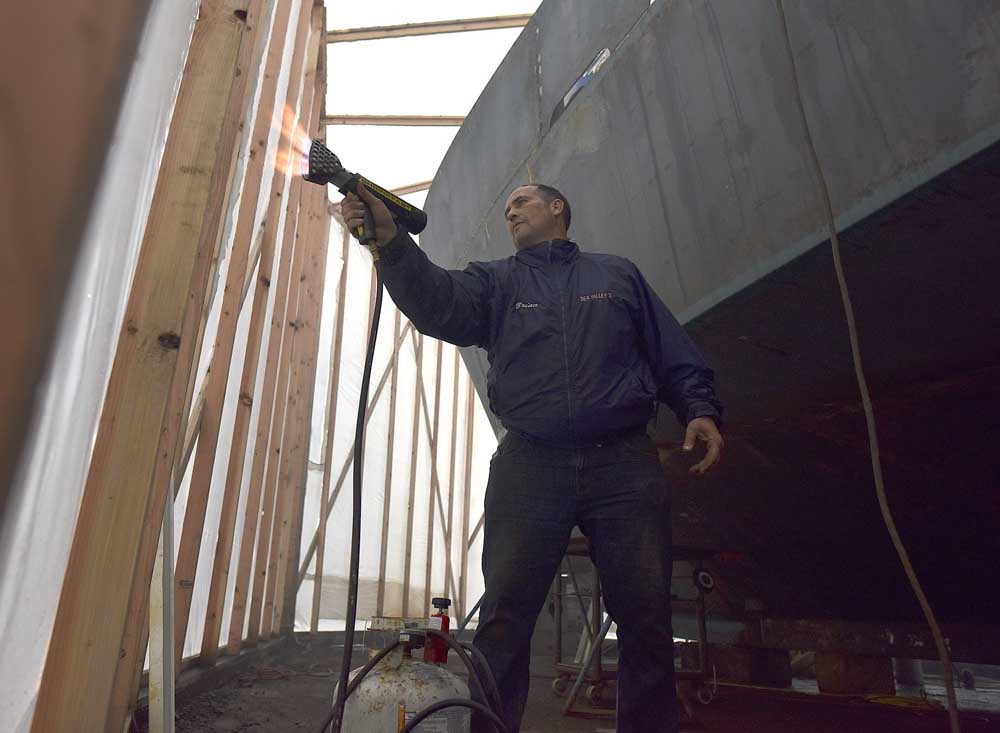Climate and crab
Published 5:05 am Friday, November 2, 2018

- Brian Boudreau heat treats the plastic material encasing his crab boat while at the Port of Astoria for modifications.
Fishermen for lucrative Dungeness crab are already busy preparing boats and gear for the upcoming season.
What they’ll find when they hit the fishing grounds is always an open question, but researchers and fishery managers are seeing a large harmful algal bloom off Oregon’s southern coast and a mass of unusual warm water forming off Alaska.
More and more, these and other events tied to a shifting climate threaten the fishery, determining when seasons open and how successful fishermen are after they drop their pots.
“We don’t see these challenges going away,” said Troy Buell, with the Oregon Department of Fish and Wildlife’s marine resources program.
“Our ability to adapt to what’s going on in the ocean will determine if we’re successful or not.”
In recent years, blooms of domoic acid, a naturally occurring marine toxin that can accumulate in razor clams and then potentially in crab meat, has delayed, curtailed and even shut down crabbing seasons on the West Coast.
The increasing number of blooms led to regulatory changes in Oregon this year. The state now requires the fishing industry to track crab from when it is landed to when it reaches consumers. Fishery managers hope the move will provide more flexibility within the fishery itself when marine toxin levels spike, while also improving the state’s ability to track contaminated crab.
This summer, the state also began looking at ways to increase its management flexibility when it comes to closing or opening areas along the coast in response to events like harmful algal blooms.
Meanwhile, the industry is grappling with issues like how to best address the entanglement of whales in crabbing gear along the West Coast, as well as the rise of ocean acidification and low-oxygen conditions — hypoxia — that threaten both the Dungeness fishery and the shellfish industry as a whole.
It’s a lot.
The industry-funded Oregon Dungeness Crab Commission is well aware of all the challenges the fishery faces. Among the commission’s top priorities are to find ways for the industry to reduce the chances of whale entanglements and to support research into why Oregon is seeing increased occurrences of hypoxia, said Tim Novotny, the commission’s spokesman.
But by the numbers, Oregon’s Dungeness crab fishermen had a great last season.
The season, which traditionally starts Dec. 1, got off to a rocky start, delayed first by crabs that didn’t pass state “meat fill” tests and then by price negotiations and bad weather. However, when crabbers finally hit the water in late January, they landed 23 million pounds in Oregon for a total ex-vessel value of $74 million, according to preliminary data collected by the state.
For comparison, fishermen landed 20 million pounds for $62 million in the 2016-17 season, and only 14 million pounds for $51 million in the 2015-16 season.
Last season’s record landings far exceeded Alan Shanks own predictions — and he isn’t sure if that’s a good thing.
Shanks, a professor at the University of Oregon’s Oregon Institute of Marine Biology, has been predicting Dungeness crab abundance season to season for 18 years. He looks at the abundance of megalopae — Dungeness in one of its larval stages — to help predict the size of the commercial catch four years later. Up until this last season, his predictions were more or less correct.
“I was within plus or minus 12 percent, which for a fishery prediction is really good,” he said.
Shanks theorizes, though he can’t be sure, that several years of warm ocean conditions — the anomalous warm water, nicknamed “the Blob,” that persisted off the West Coast in 2013 through 2015, followed by a massive El Nino in 2016 — created a situation where crab larvae grew very quickly.
Last season, it is likely fishermen caught a mix of the usual 4-year-old crabs, as well as a bunch of 3-year-olds that looked like they were older.
“Now if that actually happened, there’s a good chance my prediction for this upcoming fishing season will be too high,” Shanks said.
But he can’t say for sure. What he can say is this:
“I think a more important way of looking at this is the Blob was, according to the meteorologists, definitely the result of climate change and the strong El Nino was probably strengthened due to climate change.
“So this is the first pretty clear indication that climate change is starting to affect the crab pot fishery and the crab population.”
Crabber Brian Boudreau isn’t taking last season’s numbers for granted, either. He is lengthening and widening his boat, changes that will double what the boat can carry in landed crab.
And where Boudreau could comfortably fit 150 crab pots before, he estimates he will now be able to carry 400 to 500.
Other fishermen he knows are doing the same, coming to a similar conclusion as Boudreau did after his crew struggled to get gear out last season because of the bad weather.
If Dungeness seasons continue to open late — as they have for several years now — fishermen are calculating their chances of heading out in worse weather.
“Who knows when we’re going to go off this year,” Boudreau said.





